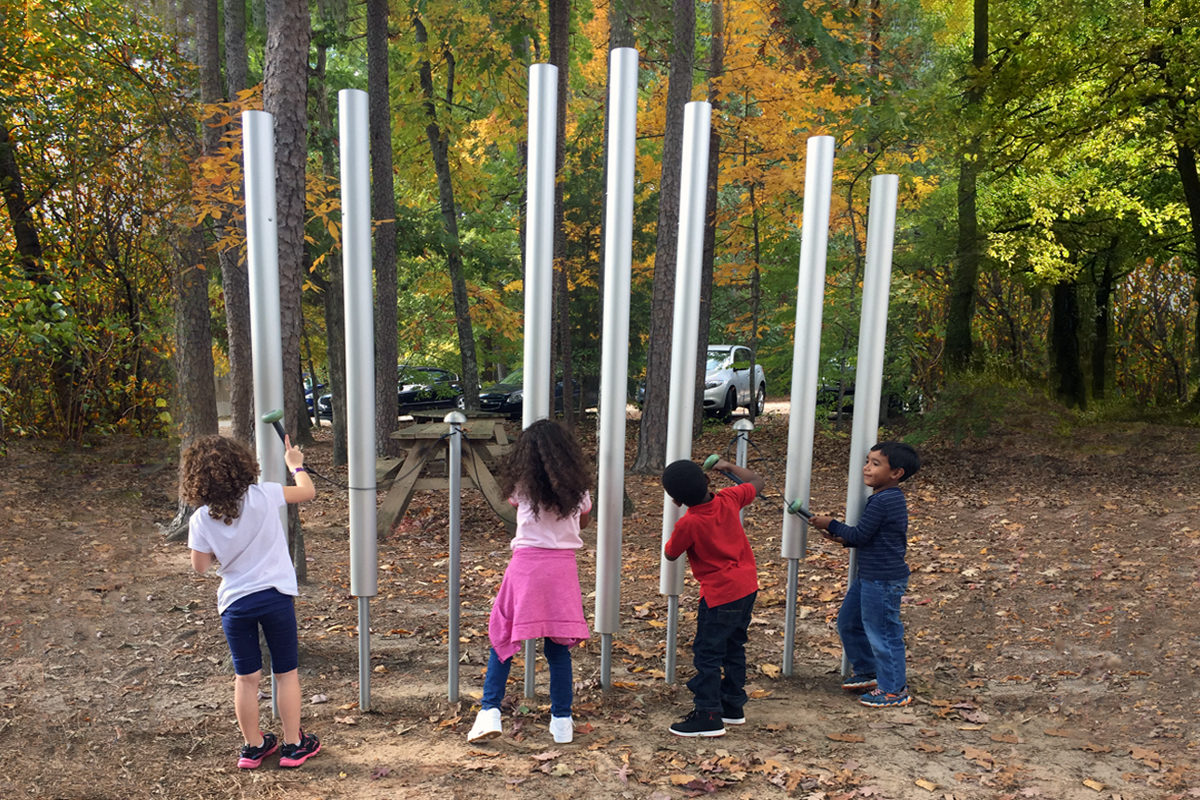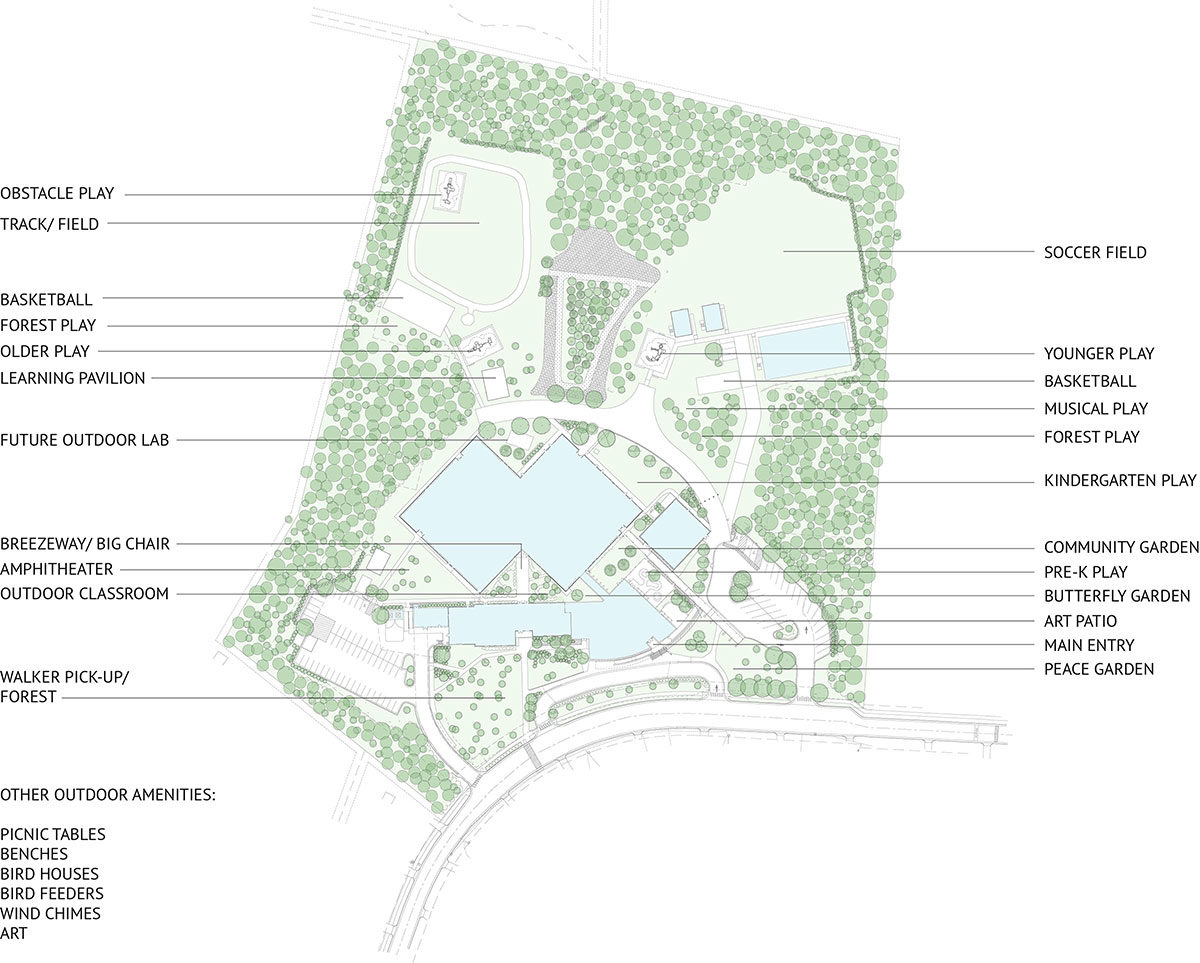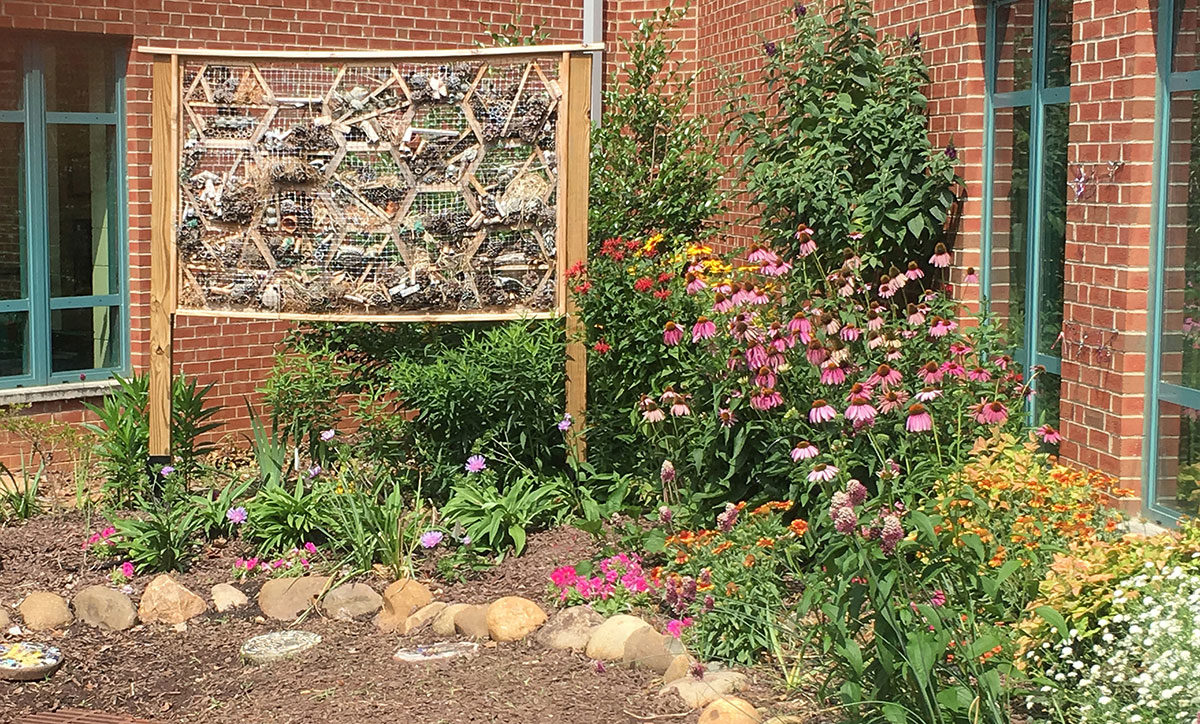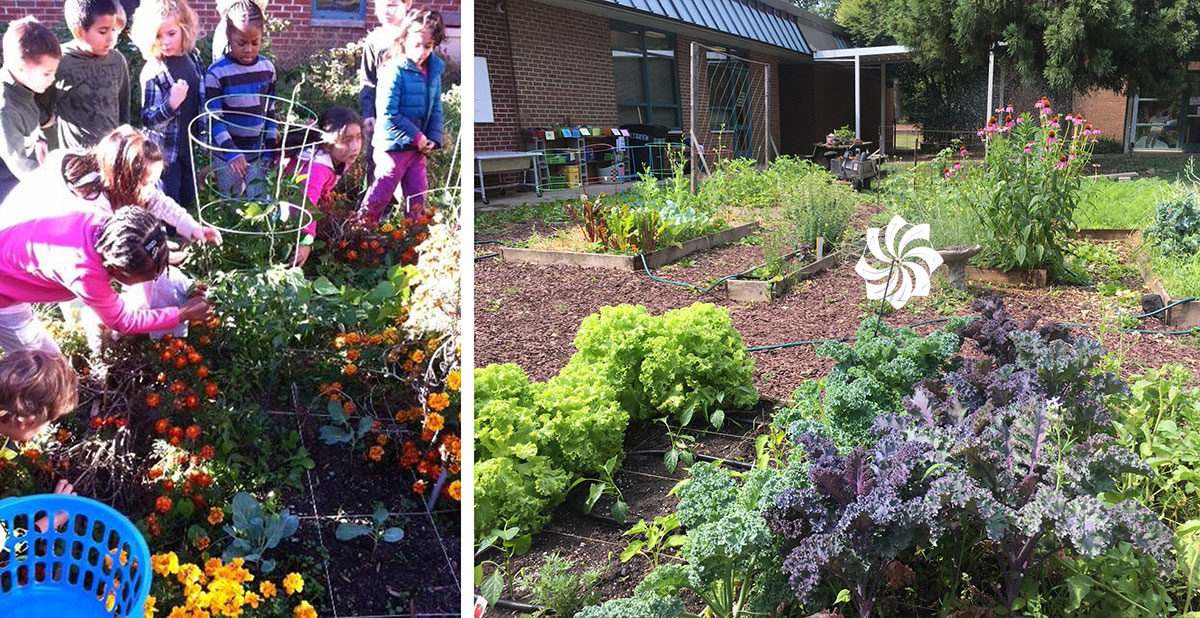A Look at Integrating Outdoor Environments in K-12 Education

The creation of spaces for outdoor learning and experiences is gaining traction in K-12 school design. Looking beyond play time, growing recognition of the significant benefits associated with time spent outdoors is driving the integration and use of outdoor classrooms, amphitheaters, diverse types of gardens, outdoor labs, and art spaces, among others.
w
As presented by Becky Brady in “The Value of Outdoor Environments to K-12 Learning, Health, & Student Safety,” outdoor experiences promote the mental and physical health of people of all ages – and notably, at the K-12 level, contribute to better student engagement, learning, and healthier social interactions.
The beauty of the great outdoors, for many schools, is its availability. While suburban and rural schools have an advantage in terms of space and campus size, most schools have some sort of outdoor area that can be leveraged to the benefit of students. Taking availability to the next level centers on creating the types of spaces that draw people outside – meaning making spaces that are engaging, easy to use for both teachers and students, and plentiful.
Douglas Magnet Elementary School in Wake County, NC, features a campus noted for its diverse set of outdoor learning, play, and social spaces. Structured and unstructured, hardscape and softscape, these environments deliver on what Derek Burns, the school’s principal, describes as a forward-thinking educational culture.
“Our teachers are very open to trying new things,” said Burns, “and we are all always looking at how to encourage students to try new things, too. Outdoor environments seemed to be a natural extension of what we were already doing in the classroom.”
Following a flexible “take-an-idea-and-run-with-it” approach, Burns has overseen the growth of multiple varied spaces for outdoor experiences. Some were driven by teachers, others by students, a portion by landscape architect CLH design, and still others by the surrounding community. The result is a broad array of outdoor areas and a school community with a strong sense of ownership for those spaces. In fact, the school’s fifth grade students recently conceived, organized, and executed their own “campus cleanup day.”
Leveraging the school’s expansive campus, its many outdoor environments include an amphitheater, outdoor classroom, future outdoor lab, learning pavilion, musical and forest play areas, a community garden, butterfly garden, art patio, and peace garden, in addition to typical play and recreation areas. The inclusion of elements like bird houses, bird feeders, wind chimes, and art, most of which are made by the students themselves, make the outdoors an engaging cultural experience and align with Douglas’ role as the creative arts and science magnet elementary school.

Structured vs. Unstructured Outdoor Experiences
Natural spaces tend to draw students, particularly for purposes of exploratory play, more so than a structured environment like a playground. Douglas’ nature path and imagination playground are popular unstructured areas, developed by students, where kindergarteners can make piles of sticks, find natural objects, and create their own “spot,” – all while learning how to play appropriately with elements like rocks and sticks. Burns notes that contrary to popular belief, students typically already have a sense of what is and isn’t appropriate play. By offering the freedom for them to interact in the natural world, teachers can provide guidance while the kids are allowed to be kids. A number of these outdoor environments allow for both structured and unstructured play and learning. The musical playground, for example, can be a teaching tool or accommodate free play.
Burns’ experiences and the diversity of outdoor spaces found at Douglas align with research cited in Brady’s article on outdoor learning, which highlights the following: “In several studies, when play areas were changed to encompass a variety of play opportunities, students performed better than if restrictions were placed on play. Students classified as having poor behavior experienced the greatest benefits in terms of energy, happiness, and less stress.”
Make It Easier to Teach Outdoors
The inclusion of outdoor chalkboards, and spaces like the amphitheater and pavilion, make it easier for teachers to transition the whole class outside and have a seamless teaching experience. Burns notes that encouraging teacher comfort in outdoor environments is key to their usage and achieving maximum benefits for students. He believes for schools prioritizing outdoor learning, they must also actively support ongoing staff development related to the confident use of outdoor spaces. The setting and tools are different, and preparing teachers for success enables students to have more freedom and a greater voice in the outdoor learning venue.
Making the interior and exterior of the school work together is an important aspect of encouraging outdoor learning. At Douglas, the interior corridor that passes by the butterfly and community gardens features photographs and information about the flowers and plants, which can be seen directly outside. Burns leads by example to promote making outdoor learning a priority and remind teachers to bring classes outdoors. He can often be found taking phone calls outside, most frequently in an oversized reading chair. His commitment to flexible, collaborative environments is evident in his office as well – there is no desk or office chair, but instead a circle of seats for more relaxed interactions.

The butterfly garden is also home to the popular “bug hotel,” a piece created by a local artist in conjunction with the school’s students. This collaboration is representative of Douglas’ key goals as a creative arts and science magnet school, giving students the opportunity to work closely with professionals through project-based learning.
Offer Dynamic Learning Experiences
When Burns became principal of Douglas five years ago, the school had begun its evolution toward maximizing dynamic learning experiences. This involved a transition from traditional classrooms to more flexible seating, experimenting with different seating types and arrangements, and encouraging movement and engagement in unexpected ways. Each classroom has an opportunity for students to use standing desks, or “wiggle seats,” and the Media Center includes exercise bikes, stretching chairs, “nook” chairs, and exercise balls in lieu of the traditional static seating.
The creation of varied outdoor spaces presented an opportunity to apply the learning strategies they were practicing inside outdoors as well. One recent example of dynamic learning outdoors was a geo-caching activity led by the STEAM teacher and magnet coordinator, which included all classes in each grade level. Immensely popular with students, this activity involved using a global positioning system receiver (or a mobile device) to hide and seek containers, called “caches” or “geocaches” marked by coordinates.
Involve the Community
Recently included in a tour of gardens in the Wake County Public School System, Douglas’ community garden originated from a grant several years ago and took shape through the efforts of teachers and parents. The community garden, which produces fruits, vegetables and pollinator plants (or, to put it more poetically, grows “veggies, flowers, curious minds, vivid imaginations, and healthy children”), is a community resource as well as an educational one and is run by a parent volunteer. Students of all ages benefit from the garden’s instructional qualities as it teaches cross-subject, integrating fractions, ecosystems, insects, and more.

One fifth grade student, Celia, shared that outdoor education helps her learn “because we can relate more with nature.” The community garden provides critical hands-on learning opportunities that enable students to engage with the natural environment while correlating with specific curriculum.
As a teaching tool, garden-related tasks such as composting may tie into curriculum for different grade levels, and students are exposed to healthy food choices as they taste much of the harvest. Kindergarteners may plant carrots in the winter and harvest them in late spring, just before school is out. Ultimately, fruits and vegetables produced by the garden are donated to Backpack Buddies and Plant-A-Row. Beyond learning opportunities, the garden’s role in connecting the school and the community reinforces the notion that schools are at the heart of our communities and we all have a role to play in student safety and development. This role has important implications for supporting student mental health and promoting a safe environment, as noted by Brady, “Direct involvement with the care of nature translates to healthy social interactions between students and other students, staff, and family members.”
Douglas has reaped many benefits from its efforts to get outdoors with students. Notably, the school does not see many disciplinary visits to Burns’ office – perhaps the most significant indicator of good student behavior, and in turn, their happiness. This finding is in accord with the growing body of research around outdoor time and mental health cited in “The Value of Outdoor Environments to K-12 Learning, Health, and Student Safety,” which indicates that in general, violence is reduced in areas with more natural elements and green environments. In the article, Brady notes, “Equally significant, students more willingly open up to teachers and staff after consistent exposure to outdoor environments, which leads to trusting relationships and the possibility to have difficult conversations.”
As schools across the nation consider what types of outdoor spaces to include on their campuses, Douglas can serve as a case study for how a diverse set of environments supports the holistic concept of student wellbeing. In addition to being a critical learning and retention tool, outdoor experiences reinforce students’ mental and physical health, critical thinking, problem solving, and interpersonal communication skills – skills that will be equally important to their future success and growth as traditional subject matter.
Video and photos courtesy of Douglas Elementary School and Becky Brady.
Becky Brady, AIA, ALEP, CDT, LEED AP BD+C, specializes in K-12 and educational design. As a member of a national taskforce created by the Association for Learning Environments (A4LE), Becky studied the many different aspects that impact school safety. To learn more about our K-12 practice or to discuss the impact of outdoor experiences for K-12 students in greater detail, please contact Becky at rbrady@clarknexsen.com or 919.828.1876.
Derek Burns, Principal of Douglas Creative Arts & Science Magnet Elementary School, views his primary responsibility as building capacity in his team that supports their cross-curricular lesson integration. By enabling staff development, students are provided with innovative and creative learning methods that keep them engaged in relevant work. In 2016, Douglas was recognized as the #1 magnet school in America and consistently ranks as a top magnet school.
